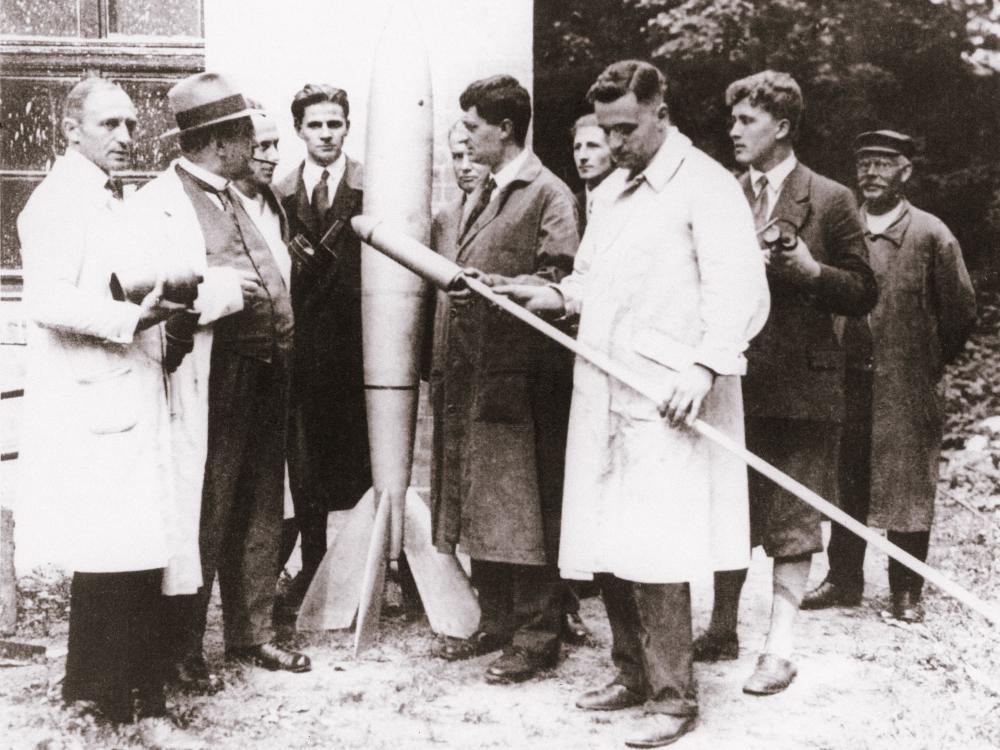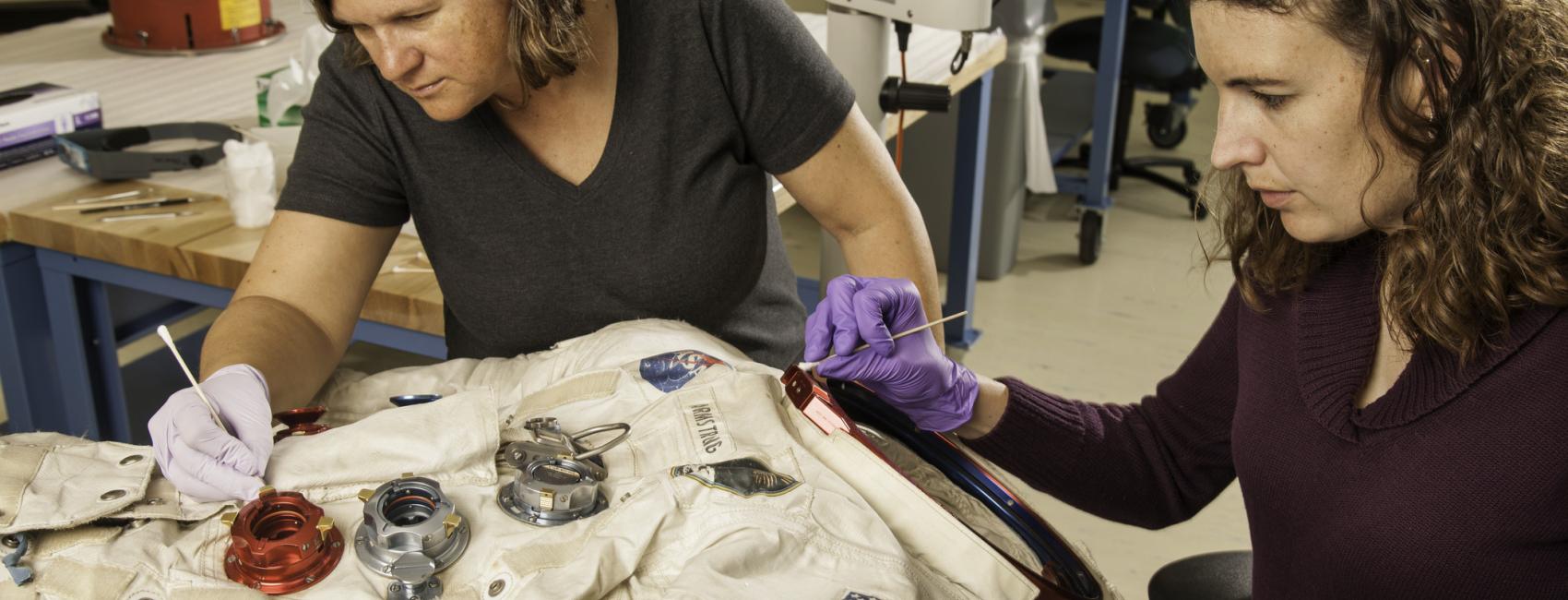
Apr 03, 2025
Picture this: the year is 1931. Humans took to the skies in the first airplane less than 30 years ago. You just read a pretty crazy book—The Conquest of Space by David Lasser—how a rocket could power a trip to the moon. Could space travel really be just on the horizon?
You want to learn more, but where do you even begin? Well, you might join a rocket society.
Mechanical engineer James “Jimmy” Hart Wyld had almost the exact experience described above. After reading Lasser’s The Conquest of Space, he dreamed of spaceflight and shortly thereafter joined the American Rocket Society (ARS).
Beginning in the late 1920s, spaceflight enthusiasts banded together into groups to advance their cause. Known as “rocket societies,” these groups of enthusiasts especially flourished in the Soviet Union, Germany, and the United States. Most groups quickly moved toward developing the one technology that pointed a way into space: the liquid-fuel rocket.
Formerly the American Interplanetary Society (AIS), the American Rocket Society (ARS) was founded in 1930 in New York City by Edward and Leatrice “Lee” Pendray. Initially, it was a group comprised mostly of science fiction writers. Members were typically men; Leatrice was a notable exception. The membership of ARS reflected how popular writing science fiction was in America. While the explosion in popularity of space fantasy inspired many young Americans to believe in the possibility of space flight, it also caused some adults to write off the concept of space travel as thing of mere fiction.
In 1931, the Pendrays visited Berlin. They watched a rocket test and befriended Willy Ley, an influential German spaceflight enthusiast. This trip marked a shift at ARS from theory to practical experimentation. ARS carried out its own rocket tests that same year but did not have a successful launch until 1933. Engineers and technicians came to dominate its leadership rather than the science fiction writers of its early days. Looking to garner more respect from their peers, the name of the society was changed from the American Interplanetary Society to the American Rocket Society in 1934.
ARS went on to have many connections to the early development of rocketry in the U.S. For instance, ARS member James Wyld became the chief engineer at Reaction Motors, which he and other ARS members founded. There, he designed a “regeneratively cooled” liquid-fuel engine. With this approach, propellant circulating around the combustion chamber and nozzle kept the engine from overheating. He also helped design Reaction Motors’ XLR-11 engine. It powered Chuck Yeager’s Bell X-1, which broke the sound barrier in 1947.
On America’s other coast, one of the most important American rocket groups formed in Pasadena, California from 1935-1936 led by Frank Malina. Nicknamed the “Suicide Squad” for their dangerous experiments with rocket propellant, the group was based out of the California Insititute of Technology (Caltech) under the famous aerodynamicist Theodore von Kármán. The group soon became the Jet Propulsion Laboratory—avoiding the term “rocket,” which many still considered a fantasy. In 1942, von Kármán, Malina, and others founded Aerojet Corporation to mass produce takeoff-assist rocket engines for heavily loaded airplanes.
In 1927, the Verein für Raumschiffahrt (VfR), or the Society for Space Travel, was founded in Germany. Its founding members included church administrator Johannes Winkler, rocket experimenter Max Valier, and science writer Willy Ley. Among the membership was Hermann Oberth, a German Romanian, whose 1923 book The Rocket into Interplanetary Space aided in the rise in popularity of space travel and rocketry in Germany. In it, he predicted that liquid-fuel rockets could launch people in space.
Beginning in 1930, several members of the VfR conducted liquid-fuel rocket experiments. The society itself founded the Raketenflugplatz Berlin, or Rocketport Berlin, a rocket launch pad where the society conducted many of its tests. However, it was put out of commission in 1934 as the military took over all research into rocketry in Nazi Germany. Several members of the VfR, such as Wernher von Braun, went on to be important in the development of rocketry for the German Army. Von Braun himself was instrumental in the creation of the V-2 missile in World War II. He and others would go on to become important rocket engineers in the United States following the war via Project Paperclip.
In the Soviet Union, Friedrich Tsander and Konstantin Tsiolkovsky founded the Society for Studies of Interplanetary Travel in 1924. Both Tsander and Tsiolkovsky published articles on theories about human spaceflight. While the society itself was short lived, Tsander’s and Tsiolkovsky’s work was not.
A Moscow-based group called Gruppa izucheniya reaktivnogo dvizheniya (GIRD), or the Group for the Study of Reactive Motion, was founded in 1931. While there had been a number of amateur groups and solitary researchers in the Soviet Union (such as the Society for Studies of Interplanetary Travel), GIRD was the first large professional rocketry program. GIRD consisted of four brigades and ten projects to study rocket engines and winged and wingless missiles. Tsander headed the GIRD's 1st Brigade. Aeronautical engineer Sergey Korolev was the group’s director. Korolev went on to lead the Soviet Union’s space program. In 1933, GIRD was incorporated into the Reaktivnyy nauchno-issledovatel’skiy institut (RNII), or the Reaction-Engine Scientific Research Institute.
Beginning in the early 1920s, rocket societies laid the foundations for the first groups of professional corporate and government run rocket operations. Some of these initial enthusiasts became leaders of later Nazi, Soviet, and American rocket programs. While these societies were initially established with the goal of simply making a functional rocket, as the world again edged toward World War II, they inevitably worked on weapons as well.

We rely on the generous support of donors, sponsors, members, and other benefactors to share the history and impact of aviation and spaceflight, educate the public, and inspire future generations. With your help, we can continue to preserve and safeguard the world’s most comprehensive collection of artifacts representing the great achievements of flight and space exploration.
We rely on the generous support of donors, sponsors, members, and other benefactors to share the history and impact of aviation and spaceflight, educate the public, and inspire future generations. With your help, we can continue to preserve and safeguard the world’s most comprehensive collection of artifacts representing the great achievements of flight and space exploration.